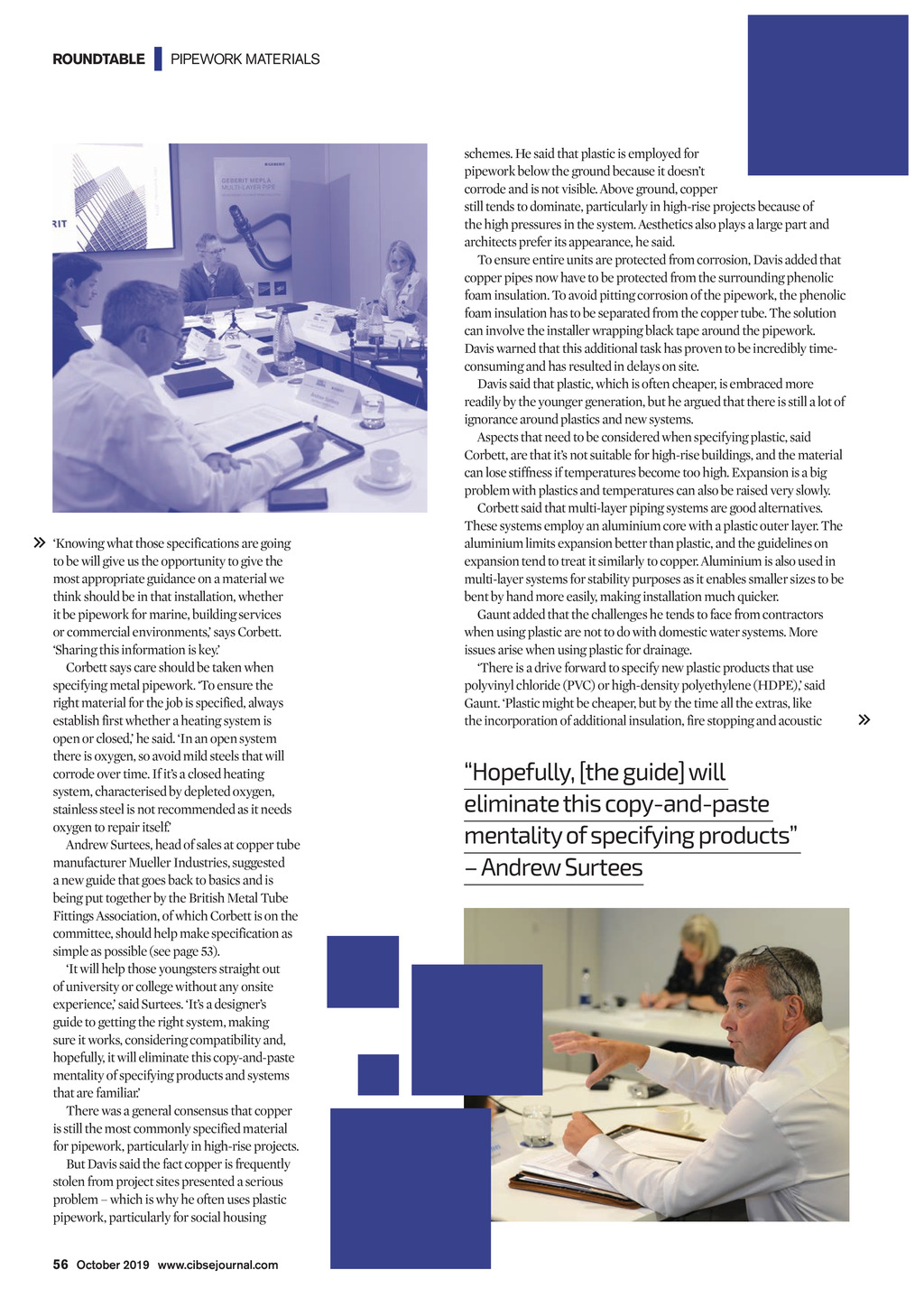




ROUNDTABLE | PIPEWORK MATERIALS Knowing what those specifications are going to be will give us the opportunity to give the most appropriate guidance on a material we think should be in that installation, whether it be pipework for marine, building services or commercial environments, says Corbett. Sharing this information is key. Corbett says care should be taken when specifying metal pipework. To ensure the right material for the job is specified, always establish first whether a heating system is open or closed, he said. In an open system there is oxygen, so avoid mild steels that will corrode over time. If its a closed heating system, characterised by depleted oxygen, stainless steel is not recommended as it needs oxygen to repair itself. Andrew Surtees, head of sales at copper tube manufacturer Mueller Industries, suggested a new guide that goes back to basics and is being put together by the British Metal Tube Fittings Association, of which Corbett is on the committee, should help make specification as simple as possible (see page 53). It will help those youngsters straight out of university or college without any onsite experience, said Surtees. Its a designers guide to getting the right system, making sure it works, considering compatibility and, hopefully, it will eliminate this copy-and-paste mentality of specifying products and systems that are familiar. There was a general consensus that copper is still the most commonly specified material for pipework, particularly in high-rise projects. But Davis said the fact copper is frequently stolen from project sites presented a serious problem which is why he often uses plastic pipework, particularly for social housing schemes. He said that plastic is employed for pipework below the ground because it doesnt corrode and is not visible. Above ground, copper still tends to dominate, particularly in high-rise projects because of the high pressures in the system. Aesthetics also plays a large part and architects prefer its appearance, he said. To ensure entire units are protected from corrosion, Davis added that copper pipes now have to be protected from the surrounding phenolic foam insulation. To avoid pitting corrosion of the pipework, the phenolic foam insulation has to be separated from the copper tube. The solution can involve the installer wrapping black tape around the pipework. Davis warned that this additional task has proven to be incredibly timeconsuming and has resulted in delays on site. Davis said that plastic, which is often cheaper, is embraced more readily by the younger generation, but he argued that there is still a lot of ignorance around plastics and new systems. Aspects that need to be considered when specifying plastic, said Corbett, are that its not suitable for high-rise buildings, and the material can lose stiffness if temperatures become too high. Expansion is a big problem with plastics and temperatures can also be raised very slowly. Corbett said that multi-layer piping systems are good alternatives. These systems employ an aluminium core with a plastic outer layer. The aluminium limits expansion better than plastic, and the guidelines on expansion tend to treat it similarly to copper. Aluminium is also used in multi-layer systems for stability purposes as it enables smaller sizes to be bent by hand more easily, making installation much quicker. Gaunt added that the challenges he tends to face from contractors when using plastic are not to do with domestic water systems. More issues arise when using plastic for drainage. There is a drive forward to specify new plastic products that use polyvinyl chloride (PVC) or high-density polyethylene (HDPE), said Gaunt. Plastic might be cheaper, but by the time all the extras, like the incorporation of additional insulation, fire stopping and acoustic Hopefully, [the guide] will eliminate this copy-and-paste mentality of specifying products Andrew Surtees 56 October 2019 www.cibsejournal.com CIBSE Oct19 pp54-56, 58 Roundtable.indd 56 20/09/2019 16:07